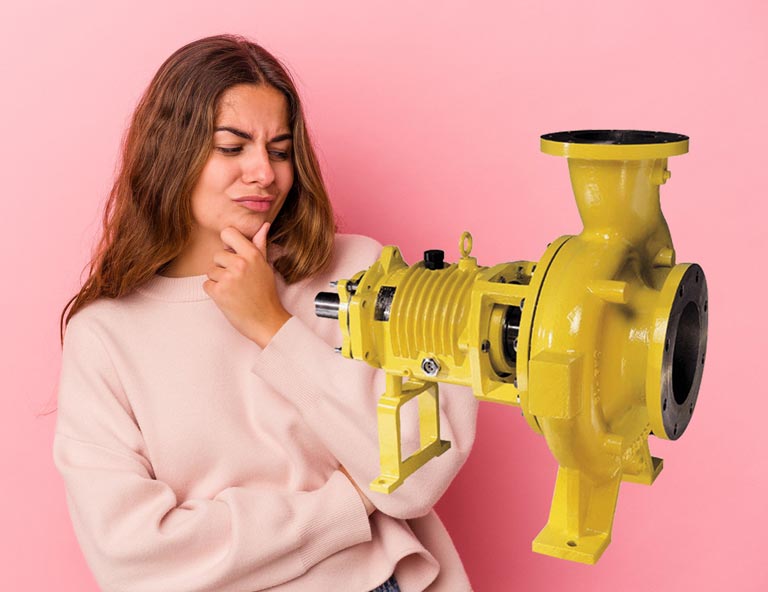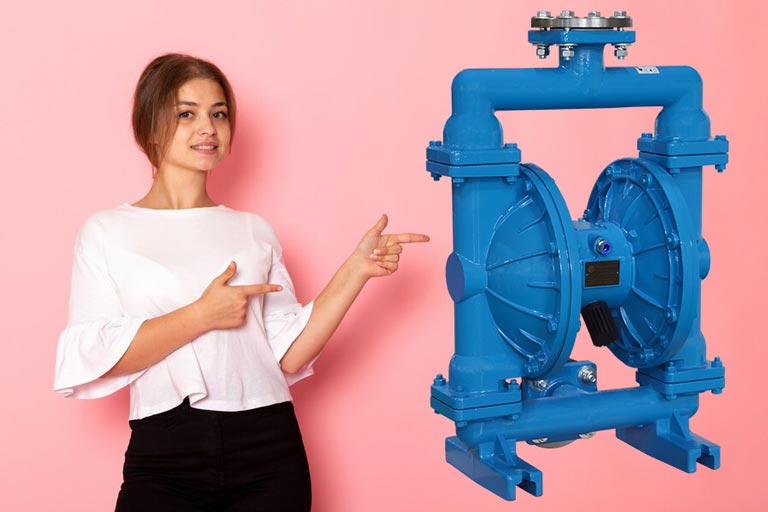What is a centrifugal pump ? In general terms, centrifugal pumps are used to transfer fluid from one point to another. There are different types of pumps, each of which has a specific application. In this unit, centrifugal pumps are one of the most important ones that are used. In this article, we will learn about centrifugal pumps from the Soolati site and explain how the centrifugal pump works.
Definition of centrifugal pump
Types of centrifugal pumps
Centrifugal pump impeller
Centrifugal pump components
Centrifugal pump power
Centrifugal pump buying guide
Definition of centrifugal pump
Centrifugal pump is known as centrifugal pump. The centrifugal pump is one of the most common types of water pumps for transferring water and liquids. These types of pumps pump liquids by converting mechanical power into fluid flow pressure energy. This mechanical power is usually provided by an engine or an electric motor, and the centrifugal pump uses centrifugal force to pump liquids.
Centrifugal pumps are widely used in the whole world and industries prefer them to positive displacement pumps.
Types of centrifugal pumps
Pumps are divided into several categories that have different types. Their types include centrifugal pumps , reciprocating pumps, and gear pumps, etc., and we will discuss the differences between them below.
Today, these pumps are widely used in food and dairy industries, metals, oil and petrochemical, paper making, industries and mines, disposal of waste materials, etc.
The operation of these pumps is such that the fluid leaves the outlet of the first pump and enters the second pump.
Centrifugal pump work is based on centrifugal force, in fact, the moving part of the pump drives the fluid out from the center under rotational motion, and because the drops have high acceleration and speed in this state, when they collide with the inner wall, their speed is reduced to pressure. converted and during this process our fluid is pumped.

Reciprocating pumps
These pumps are devices that transfer energy from them to the fluid periodically. But these types of pumps are often driven by electric motors. In this type of pumps, the rotational movement of the crankshaft becomes the reciprocating movement of the piston in a cylinder. When the piston moves back, suction is created in the cylinder, and as a result, the liquid enters the cylinder through an inlet valve. As the piston moves forward, the inlet valve is closed and the liquid is directed out through the outlet valve. The inlet and outlet valves are one-way and are made in such a way that the liquid inside the cylinder is prevented from entering the low pressure part and vice versa during the piston travel.

Centrifugal pumps
What is a centrifugal pump ? Centrifugal pumps are usually driven by an electric motor. The driving force is transferred from the engine to the pump through an axis called a shaft.
The motor shaft is connected to the pump shaft by a type of mechanical equipment called coupling. In this way, power transmission is easily transferred to the pump shaft through the electric motor shaft.
Centrifugal pumps have a housing that is spiral-shaped and called a shell or casing, and inside there are one or more wheels that are mounted on an axis (shaft).
Each wheel is equipped with a number of spokes. Energy transfer to the fluid is done in this part. In order to prevent fluid from leaking out of the pump casing from the shaft exit, a tool called mechanical seal has been used.
A very important point about these types of pumps is airing or priming the pump before turning them on.
That is, after lining up the pump and ensuring that the fluid enters the pump, it is necessary to ensure the complete exit of the air or gas trapped inside the pump. These types of pumps are made in different dimensions and sizes for different purposes. These pumps are of a type that transfers energy from them to the fluid permanently.
Centrifugal pump impeller
If instead of a plunger piston, it travels inside the cylinder, in this case it is called a plunger pump. Meanwhile, if the plunger moves the diaphragm, the pump is a diaphragm type.
Difference between piston and plunger
The difference between the piston and the plunger is that the length of the piston head is shorter than the distance that the piston travels inside the cylinder, while the length of the plunger is longer than the distance traveled by it inside the cylinder.
Ring piston pumps
In piston pumps, a ring is used to seal the piston and cylinder, which is placed on the piston body and moves with it, while in plunger pumps, this ring is located on the cylinder and is fixed. These pumps are usually of low capacity, but they can increase the output pressure of the fluid by a large amount. Therefore, these pumps are used in places where there is a need to move fluid with low volume but high pressure. In addition, it should be noted that the fluid flow in these pumps is non-uniform. A very important point about these pumps is that they should never be turned on while the pump outlet valve (discharge pump) is closed. The gear pumps of these electropumps are a type of circulating or rotary pumps.
Gear pumps
These pumps consist of two distinct parts, one is a fixed wall part and the other is a rotating part that includes a rotating shaft with a gear. In gear pumps, some liquid gets trapped between the gears of the pump gear, and due to the rotation of the gears, this liquid is pushed to the outlet of the pump. These pumps are made in such a way that the distance between the rotating parts and the fixed wall is very small. These pumps are used to move liquid with low volume and medium pressure. The important thing about these pumps is that they should never be turned on while the pump outlet valve is closed; Because in this case, if there is no safety valve in the discharge path of the pump, either the pump itself will be destroyed or the DisCharge pipe will break.
Centrifugal pump components
Centrifugal pumps have different components, which we will discuss below.
- I saw
- Abrasion rim (butterfly and shell)
- Sealing system
- Bearings
- system (flushing)
- Coupling
- Cyclone
- filter and strainer
- impeller
- shell
The movement of the engine is transferred to the propeller by means of a shaft. The fluid moves from the spring of the propeller towards the blades and flows along the blades towards the environment of the propeller. The pump impeller is responsible for transferring energy to the fluid.
butterfly building
A butterfly is made up of different parts.
- propeller hub
- It is in contact with the axis of the pump, and the pin or key to connect the propeller to the shaft is on it.
- Vane blades
- After entering the propeller spring, the fluid flows along the blades towards the propeller environment. During the movement of the fluid, its kinetic energy increases.
- fascia (shroud)
- It forms the side wall of the propeller. It is possible that both sides of the blades have an envelope or one side or not at all.
- butterfly fountain (eye)
- The fluid enters the propeller blades through the propeller spring.
- Division of propeller in terms of mechanical construction
- Enclosed impeller
- Butterfly blades are placed between two plates called shroud.
There is a possibility of impeller blockage because our solid materials get stuck between the plates. These types of blades are used to pump fluids that contain solid materials. is not used
Centrifugal pump power
Centrifugal pump power can create output power or hydraulic power after losing some energy due to volumetric and mechanical hydraulic losses. Hydraulic power is the product of the pressure multiplied by the pump flow rate.
hydraulic power
It depends on the output power of the pump, which causes the fluid to move. To calculate this power, just multiply the pump pressure by the flow rate.
Pump output power
The output power of the pump is the hydraulic power of the pump.
Pump input power
The input power is the power that is given to the pump axis to create the output power. Calculating this power is also simple.
output power of the pump by the total efficiency of the pump E P. The input power is equal to the result of dividing the
(P BHP x E P = P H)
The input power of the pump is equal to the product of the input torque to the pump by the angular velocity of the pump axis
(P BHP [w]= T[N.m] x ω [rad -1 ])
Absorptive power
The pump must absorb to generate output power. The suction power is the same as the input power of the pump.
Working point power
Point power is the absorption power or input power of the pump. In fact, the pump consumes power at the working point, which is the same as the working point power.
Centrifugal pump buying guide
What is a centrifugal pump ? Today, pumps have many applications in various industries. These pumps are available in different sizes in the market.
In this article, we have discussed the important points of the centrifugal pump. We hope that this article has been liked and used by you users.
You can consult our experts who have high experience in this field for purchase or more information. To benefit from the best and most suitable type of pump.
To know the price of all types of pumps, contact the numbers listed at the top of the site.
